
A Spring Bake for Spring Break

I have been exploring the delicious world of porridge breads lately but today I decided to venture away from that...sort of. When I first started baking bread, apart from the therapeutic value of the process, my motivation was primarily nutritional. I wanted to bake bread that tasted good and was good for me...of course how the bread looked, whether the ears were big enough, oven spring, open crumb etc., all those concerns also become apparent on the learning curve but in the end taste and nutrition seem to be what matters most. Being sustained, being able to eat the less-than-perfect-not-what -was-expected results of our baking experiments has been an often stated encouragement from other bakers. We have bread to eat, baked by our own hands...that's a pretty good thing. So my focus for today's bake was first and foremost about nutrition and taste.
I have a palate preconception where bread is concerned - maybe it's because I grew up in Saskatchewan, all that prairie grain creating a taste preference in my DNA - but I like bread that tastes like the grain used to make it, nutty, grassy, mellow, the flavour of a nicely caramelized crust. But I digress...that is my underlying bread bias but not an all or nothing preference. Today I baked a bread that I think tastes pretty good while also having a solid nutritional profile - the aesthetics may have suffered a bit with less oven spring, ears but I am quickly getting rid of the evidence with one loaf going to a neighbour and the other served up for lunch.
As Danni often does, I am using pictures to share what I did for this bake...
I used 250 g mix of fresh milled, sifted (bran kept for final coating) organic rye, hard spring wheat and 750 g all purpose organic flour with 800 g water (this was a little too much water, I think 750 g would have been best) left for 1 hour at room temperature; then 220 g young levain (4 hours) and 20 g sea salt was mixed in to start the bulk fermentation. Four series of stretch and folds every half hour for the first two hours then two hours resting.
After the second series of stretch and folds, 1 hour into the bulk fermentation:
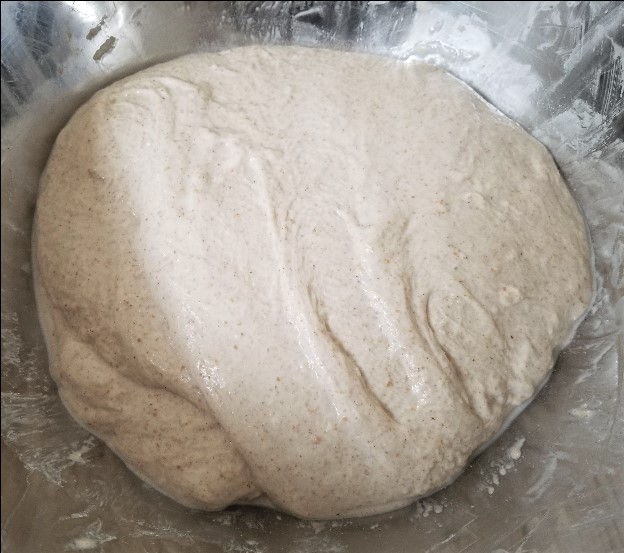
Two additions after the second series of stretch and folds:
The first one - ground up 50 g toasted sesame seeds, 100 g hemp hearts and mixed into a paste with 150 boiling water. The second - 50 g chia, 50 g golden/brown flax, 50 g toasted hemp seeds (not hearts) mixed with 250 g boiling water and left for 2 hours. I recall one of Joze's posts where he was experimenting with hemp flour and sesame; the complimentary flavours worked well in his bread so I thought adding ground hemp hearts and sesame would provide a nutritional component as well as a nice subtle flavour. The toasted hemp seeds were added for their texture and nutritional value as were the flax seeds.

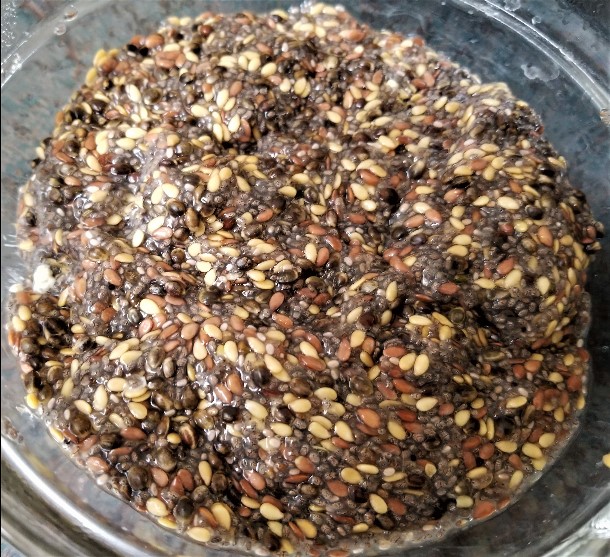

After the final set of stretch and folds, two hours...
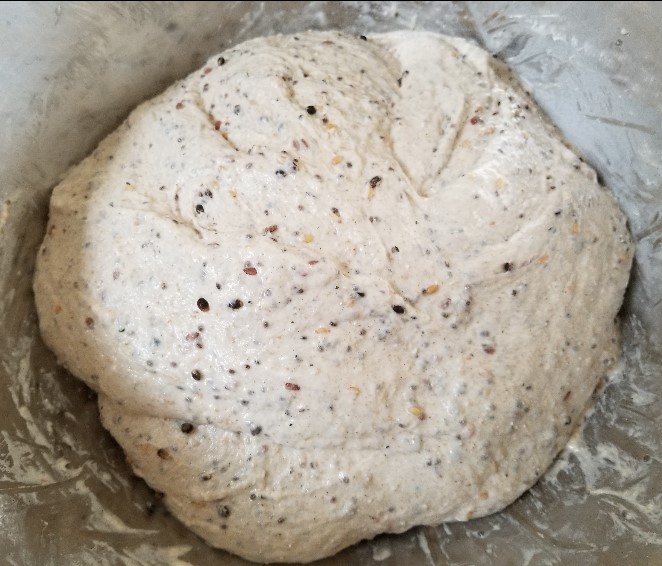
After 4 hours, pre-shaped and left to rest for thirty minutes:
I began with a generous dough hydration characteristic of the Tartine style breads I have been trying to bake but without thought to the affect of the additions on the final dough hydration. Robertson's advice for porridge breads is to cut back his typical 85% hydration to 75% to account for the porridge water. In my mind I was not making a porridge bread so autopilot was engaged and before I had thought it through I had a nice 80% hydration dough to start with...I am not sure the exact final dough hydration but by the feel of the dough at the end of the bulk fermentation (I think the soaker may have released some of it's water into the dough too) it was probably 90%+ It was a bit more challenging handling/shaping the dough.

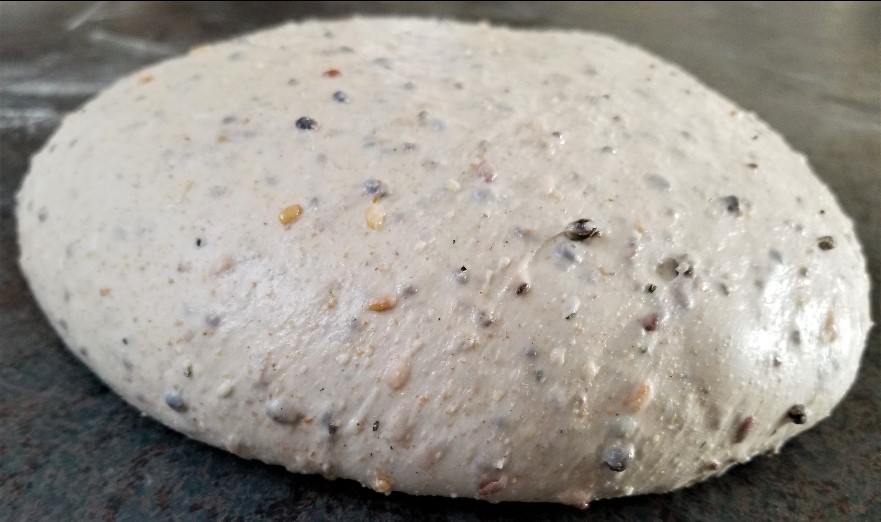
Final shaping and into linen lined proofing baskets:
I was able to gently wrestle and shape the dough into a batard and a boule (you may notice most of my posts have a boule and a batard - it's because I have one Lodge enamelled pot and one oval Creuset). The loaves were dusted with the bran sifted and saved at the start and some rice flour/flour. This bake was also different because the plan came to me early in the day and I decided to forego my preferred overnight cold -proof, doing the whole thing during my day off. Again, always amazing to me how easy it is to slip into autopilot mode - I am so used to final shaping, into baskets and then leaving the loaves overnight in the fridge for 10 hours - I left these loaves to proof in plastic bags at room temperature on the kitchen island and forgot about them! Fortunately I eventually remembered what I was doing before they were too over-proofed - I think they would have been better if baked an hour earlier but it is what it is.

Baked in pots, covered at 500 F for 25 minutes; 450 F for 10 minutes and then uncovered and directly on the oven stone at 450 F for 25 minutes:
The loaves were really floppy coming out of the proofing baskets, very challenging to score and transfer into the pre-heated pots before they spread out too much. I wasn't feeling very optimistic about the final outcome at this point but got them into the pots and into the oven hoping for the best. There wasn't as much oven spring or development of ears as I like (I know, it's just aesthetics!) but the crust and colour looked pretty good coming out of the pots at the halfway point of the bake. They took a little longer to finish, again probably because of the high hydration dough, but they finished up nicely I think.


The crumb shot:
Well, as I started with at the beginning of this post, this bake was supposed to be a change from my of late, usual porridge breads, but in the end, with the high hydration and wet pasty additions it's pretty much that again. I am happy to say, despite being over-proofed, kind of floppy, over hydrated and a bit flat coming out of the oven...this bread tastes really good! The crumb is soft, chewy and gelatinous, the crust is crisp and nutty, the hemp hearts and sesame add a really nice subtle flavour just like Joze said and the toasted hemp seeds add a great, nutty crunch every now and then - a delicious learning experience for the next time I try this.
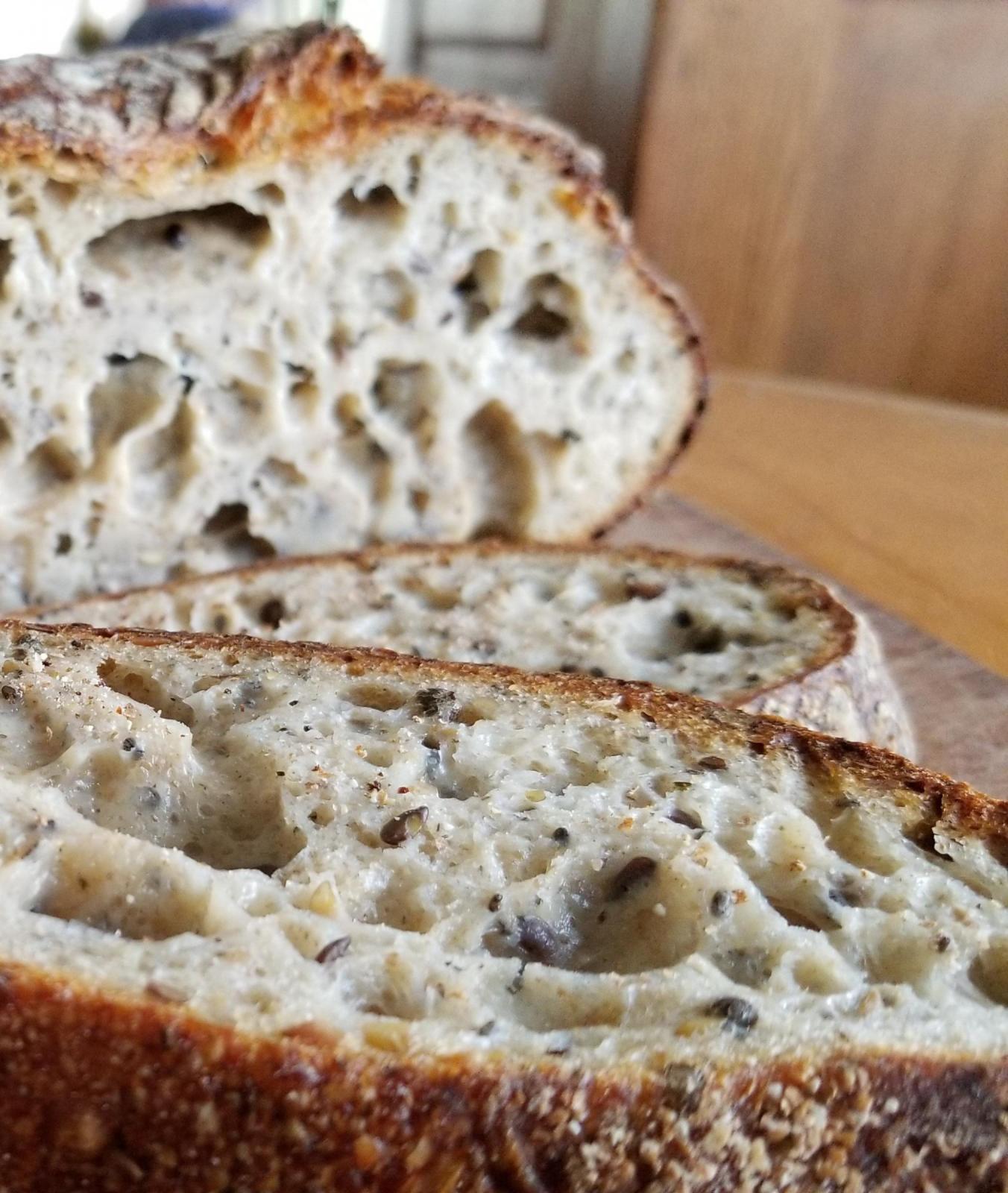


Comments
when I saw your crumb was not very lady like: “Holy $&@*!” That’s a nice, nice, custardy (is that a word?) and open crumb! It totally rivals the pictures in Tartine 3! I beat my head against the wall trying to get a crumb like that and you get it without even trying. Just wow!
And thank you for the pictures. It’s so nice to see what other people’s dough looks like along the way.
Quick question though, the initial 250 g of rye and hard spring wheat, is that 250 g together or 250 g each? If together, what is the breakdown?
I am adding this to my bookmarks although I don’t think I can find hemp seeds here, hemp hearts yes, but I haven’t seen seeds. Do you have a suggestion on what to substitute?
All in all, just a beautiful and delicious bake!
Hi Danni,
Thanks for your kind comments...the motivation for this little departure from my secure, staid and relatively predictable bread routine is from seeing the variety of beautiful, delicious breads you and the many other talented and adventurous folks on TFL are baking. It's not Wonder Bread anymore!
As to your question, the initial 250 g of rye and hard spring wheat is the net amount after milling and sifting 100 g rye and 150 g hard spring wheat. And the toasted hemp seeds, they have just recently appeared as a regular stock item at our local Bulk Barn; according to their website there is a Bulk Barn in Thunder Bay, perhaps if you ask the manager they can bring some in for you? Manitoba Harvest Hemp Hearts are sold at Costco; if you go to their website they also sell lightly salted Toasted Hemp Seeds: https://manitobaharvest.com/products/toasted-hemp-seeds/?size=28&flavor=95 If you're unable to find any let me know and I can ship some to you if you like - Richmond to Thunder Bay, shouldn't be a problem. As to substitutions, I think nutritionally you could use more flax and chia but they don't have the same crunchy texture; I like the toasted hemp seeds for the fiber and flavour too, with the toasted shell the hemp is a different flavour than shelled hemp hearts.
Bulk Barn does carry them! I am a regular customer so I will check it out the next time I am in there. I noticed that they have a bunch of new items lately such as an expanded selection of sprouted flours. I made my own so I didn’t pick any up but it’s good to see the variety. Thanks for the heads up on these! And thank you so much for the offer to ship some to me. If I can’t get them here, I’ll take you up on that offer!
I wish we could get a Costco here but they have been chased away by the local big box stores from what I understand. We keep hearing rumours that they are coming but it’s been more than 10 years and still nothing. It would be nice to get a bit more variety.
and picked some toasted hemp seeds as well as some hemp hearts as my stash was getting low. Thanks for the heads up on where to get it!
Glad you found what you were looking for Danni. I just posted a few links below to some of the local suppliers I use...Fieldstone and Anita's will ship anywhere in Canada but I don't know if it would be cost effective for you. I am fortunate to have many really good organic, non GMO grain and seed suppliers close by!
Awesome looking posts, thanks!
I get the bulk of my stuff from OM foods, a great resource, realrawfood.com the other one.
https://www.omfoods.com/seeds-seed-butters/organic-hemp-hearts-1-grade-hulled-raw/
Thanks for your kind comment and the supplier links Neil...I get some of my organic grain from Cedar Isle Farm, a small farm operation focused on growing organic, non GMO, heritage grains; other organic grains and flour I get from Fieldstone Organics and Anita's Organic. Here are the links:
http://www.cedarislefarm.ca/
https://www.fieldstoneorganics.ca/index.php
http://anitasorganic.com/
For such a healthy and chock full of goodies bread, your crumb is outstanding. Thanks for sharing. I've never used hemp anything so I will have to be on the lookout and give it a try.
Happy baking!
Ian
Hi Ian,
Hemp as a food source was something most people regarded as a hippie or heath food thing when I was growing up. It is a relatively recent interest in the nutritional value of hemp seeds that has helped it become more mainstream as a food source. Here in Canada in the 1980s and 1990s there was renewed interest in the cultivation of hemp; research conducted between 1994 and 1998 showed it could be successfully grown in Canada as a separate entity from cannabis (marijuana). Despite this distinction and even though it has a long history of use dating as far back as 10,000 years, it is still a controlled agricultural crop. If you're curious here's a link for more information:
http://www.hemptrade.ca/eguide/background/history-of-hemp
The plant fibre from the stalks is used in making paper, textiles, rope and twine and construction materials; seeds from industrial hemp are used in food products, cosmetics, plastics and fuel. Personally, I like to use hemp seeds and hemp hearts in bread! Thanks for having a look at my post Ian, looking forward to whatever lovely bread you come up with using hemp. Get baked...I mean baking!
and my hemp sesame paste is more like soup after I added the water! Does it thicken more upon standing? I let it sit while I was mixing up the flour and water and it thickened slightly. The seed mixture was very thick so I threw both together and am hoping for the best. I cut back 100 g from the main dough (being conservative as I can always add more later) so I hope it all turns out right.
Hi Danni, I just noticed the post message, hope your bake is going well! The hemp sesame paste is pretty soupy but mixing it in with the seed mixture should produce a more pasty, less gooey addition. All this variation in viscosity and hydration must surely be tweaking some of your pottery instincts but I am pretty confident your baking instincts will serve you well on this bake!
because I was thinking clay is easier to handle when I was trying to mix the seeds in with the dough! I ended up taking the dough out of the bucket, stretching it out, spreading the seed mixture on top, rolling it up several times in different directions and finally using French slaps and folds before it was somewhat homogeneous. Mixing the add-ins at the beginning is so much easier!
hydration will open the crumb every time! Getting out if your comfort zone and forgetting the loaves were proofing on the counter can also be nice. Lucy was never the same after hanseata got her hooked on hemp seeds years ago but she has lived a long time, mellowed out ust a but and came up with many dopey bread recipes as a result:-).
So how long were these loaves forgotten and left on the counter?
Happy baking
Hi Dab, you're absolutely right about opening up the crumb by getting the bran out and upping the hydration (my absent mindedness resulted in a lot more water than I planned, my intention was a FDH around 82-85% but ended up 90+%). I have since tried this bake again with more attention to the hydration (85%) and cold proofing overnight for 10 hours producing nice bread and without quite as much anxiety handling and shaping the loaves. This initial bake was exactly as you say, an adventure out of the habitual, routine baking routine to test the comfort zone boundaries. I like to do that to train and develop good bread baking skills/intuition, to force myself to actually pay attention to what I am doing! I like the meditative nature of bread baking but I am no master and too much Zen-in-the-zone-mindlessness leads to chaos, not serenity in my kitchen.
These loaves were bulk fermented at room temperature (21C) for four hours, approximately 30% rise; pre-shaped and rested for 1/2 hour on the counter and then final shaped and placed in linen lined baskets to finish proofing. I was thinking they would need 3 hours but ended up forgetting them on the counter; it was 6 and 1/2 hours when they were in the oven. I think what may have played in my favour is the late afternoon/early evening temperature dropped and so also the room temperature in the kitchen. The loaves were proofed just a little past optimum.
The third attempt, with some changes; FDH 85%; hemp hearts finely ground with chia, flax, sesame and mixed with equal weight boiling water before mixing with oat porridge; cold proofed overnight 10 hours
Did you grind all of the seeds or just the hemp? And what are you using to grind the seeds. I used a “bullet”.
For the third iteration I did grind all the seeds - equal amounts of chia, flax, sesame and hemp hearts (no hemp seeds this time); all the ground seeds were mixed into a paste with an equal amount of boiling water and left to sit for an hour before mixing in some oat porridge to soften the crumb. I was using a Bamix with a grinding bowl attachment for my previous bakes but found the Vitamix more efficient this time. Again, this is just more tinkering, essentially the same bread as the first loaves above with a few tweaks to the same ingredients.
it’s an immersion blender. The bullet wasn’t great at grinding the seeds since I had to do it in batches. I don’t have a vitamix so that isn’t an option. I have an Immersion blender, a mini chopper, a food processor or the bullet. The bullet works super well for flax but the sesame and hemp just clumped up. I might try some of the others and see if they work any better than the bullet.
The flax and hemp will clump up in whatever you use because of the oil in the seeds; I add a bit of the total water when they first start to clump, mix a bit more to ensure a good fine grind and then add the rest of the water to make up a thick paste. We had a bullet for while but it was not ideally suited to grinding seeds as much as mincing and mixing things like veggies and fruit.
I wasn’t adding the water until after the seeds were ground. I know now that my seeds were not as fine as yours and that probably affected how they absorbed the water as well. I’ll try adding some water next time.
how you managed to shape that bread at the hydration you used! I used another 2 and a half cups of flour just to stop it sticking to me, the counter and anything else that it touched. Mind you, I made 4 batches of your recipe but still!!! It is now sitting in the fridge to be baked in the morning.
Yes, this is a particularly wet, challenging dough but it is manageable; cold proofing overnight will help too. But be warned, have everything ready to go because as soon as you turn the loaves out of the baskets the clock starts and you have limited time to slash and transfer to the pots before the loaves start to spread. I managed a few quick slashes but in past, rather than mess about trying to get clean slashes I used kitchen shears to do a stego -score or other such epi type cut. Also, and I think you already do this, it is helpful to turn the loaves out onto parchment paper for easier transfer into the pots; the less handling the better. Don't be discouraged if the loaves look a little floppy and non-descript going into the pots, they will bloom and open if you've pre-shaped/shaped them as you do with any other loaf.
They are going to be baked seam side up so I will skip the scoring part. I do use parchment but it is placed in the bottom of the pots before I transfer the loaves. I’ll make sure to be quick!
Ok, maybe try putting the parchment over the basket, putting your peel on top of that and then turning everything over...then all you have to do is remove the baskets and the loaves are on the paper for easy transfer to the pots (make sure to cut the paper a bit bigger than the basket circumference so you'll have some edge paper to grab onto when you lift the loaves into the pots) Looking forward to seeing the results tomorrow!
This has never happened this fast before but did you find your loaf going moldy more quickly than usual? I went to make a sandwich yesterday, five days after it was baked, and it was moldy! Usually sourdough bread lasts for more than a week and it only goes moldy after a couple of weeks if there is a piece that gets forgotten in the bread basket.
I have water kefir going in the same area and that’s the only change that I can think of that might be causing this. Any thoughts on what happened?
Hi Danni,
I have not had any of my bread develop mold but that's probably because it doesn't get stored for very long, we tend to bake and eat only what we need so there's usually not much left over between bakes. As to your thoughts about the water kefir, I don't think that would be the culprit as kefir is a yeast/bacteria culture. The bread mold is likely from some other source...mold spores are everywhere just waiting for the right environment to grow and multiply in. I am quite paranoid about cross contaminating my starter with some of the other fermented stuff in the kitchen; koji (aspergillus fungi ), kombucha (yeast/bacteria), kimchee etc. So far it hasn't been a problem but certainly something to be aware of. Perhaps some other TFLers will be able to shed more light on your question, I am no expert on moldy bread!
This was a first for me! Like I said, sourdough bread is usually good for more than a week, if it lasts that long, around here. I have never had a loaf grow mold in 5 days!
I might have put the bread in the plastic bag when it wasn’t completely cooled so I wonder if that did it. Today, I made sure they were cold before bagging them.
Yes, if you put it in the bag before it cooled the moisture from the bread would remain in the bag and thus you get our favorite mold! I have had mold develop in the summer if it get's really humid out even though I have central air.